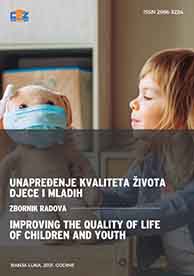KVALITET ŽIVOTA KROZ PRIZMU KOREKTIVNO-REHABILITACIONIH PROGRAMA ZA MLADE U SUKOBU SA ZAKONOM
THE QUALITY OF LIFE OF YOUNG OFFENDERS FROM THE VIEW OF CORRECTIONAL REHABILITATION PROGRAMS
Author(s): Goran Jovanić, Vera PetrovićSubject(s): Social Sciences, Psychology, Sociology, Criminology, Social Norms / Social Control
Published by: CENTAR MODERNIH ZNANJA
Keywords: quality of life; youth offenders; treatment; recidivism;
Summary/Abstract: Considering the definition made by a group of World Health Organization experts which defines the quality of living as an individual's perception of their own position in life in the context of one's culture and the system of values, as well as their own goals, expectations, standards and interests, we may presume that such a vast concept is comprised of the individual's physical health, metal state, material independence, social relations and their views on significant features of their environment. Applying such concept of the quality of living on the population of youth offenders in institutional treatments, demonstrates that the development of ideas and practice of social reactions to youth offenders has influenced the shift of focus from punitive measurements towards social protection, education, treatment and professional guidance and rehabilitation with the aim of eliminating delinquency risk factors and reinforcing socially accepted behavioral patterns. Correctional rehabilitation institutions for young offenders' treatment offer various programs to their users in the course of their incarceration. The existing programs cover a wide range of services and interventions, including rehabilitation for drug users, preservation of physical and mental health, education and professional development, reduction of aggression and other forms of asocial and antisocial behaviors. Being included in such programs for young offenders tends to enhance the quality of life of this population by removing criminal dynamic factors and creating conditions for pro-social life within the institutions as well as the post-institutional environment. Recidivism reduction accomplishes a secondary goal as well, and that is to increase public safety of the community where the offenders are integrated after leaving the correctional institutions. The aim of this paper is to demonstrate the applicative possibilities of using youth offenders' institutional programs in local conditions, by exploring various positive experiences and effects of the applied programs.
Journal: DRUŠTVENE DEVIJACIJE
- Issue Year: VI/2021
- Issue No: 6
- Page Range: 613-620
- Page Count: 8
- Language: Bosnian, Croatian, Serbian

